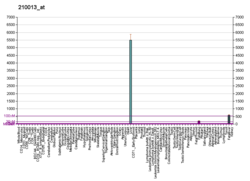Hemopexin
Hemopexin (or haemopexin; HPX), also known as beta-1B-glycoprotein is a protein that in humans is encoded by the HPX gene and belongs to hemopexin family of proteins. Hemoglobin and its scavenger protein hemopexin (Hx) associate with HDL and influence the inflammatory properties of HDL. In addition it can also be said that HDL from Hx-null mice is proinflammatory. Moreover, Hemopexin deficiency is associated with various other inflammatory diseases such as septic shock and experimental autoimmune encephalomyelitis.
Takahashi et al. (1985) determined that human plasma beta-glycoprotein hemopexin consists of a single polypeptide chain of 439 amino acids residues with six intrachain disulphide bridges and has a molecular mass of approximately 63 kD. The amino-terminal threonine residue is blocked by an O-linked galactosamine oligosaccharide, and the protein has five glucosamine oligosaccharides N-linked to the acceptor sequence Asn-X-Ser/Thr. The 18 tryptophan residues are arranged in four clusters, and 12 of the tryptophans are conserved in homologous positions. Computer-assisted analysis of the internal homology in amino acid sequence suggested duplication of an ancestral gene thus indicating that hemopexin consists of two similar halves. Altruda et al. (1988) demonstrated that the hemopexin gene spans approximately 12 kb and is interrupted by 9 exons. The demonstration shows direct correspondence between exons and the 10 repeating units in the protein. As the introns were not placed randomly; they fell in the center of the region of amino acid sequence homology in strikingly similar locations in 6 of the 10 units and in a symmetric position in each half of the coding sequence. From these observations, Altruda et al. (1988) concluded that the gene evolved through intron-mediated duplications of a primordial sequence to a 5-exon cluster.
...
Wikipedia


